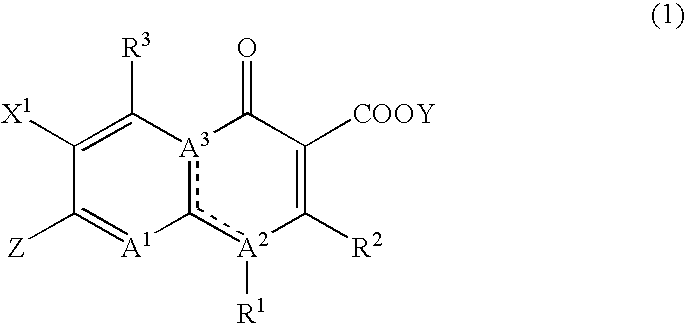Anti acid-fast bacterial agent containing pyridonecarboxylic acids as active ingredient
a technology of pyridonecarboxylic acid and active ingredient, which is applied in the direction of antibacterial agents, biocide, heterocyclic compound active ingredients, etc., can solve the problems of insufficient antibacterial activity, unsatisfactory effectiveness and safety, etc., and achieve excellent safety, good antibacterial activity, and high antibacterial activity
- Summary
- Abstract
- Description
- Claims
- Application Information
AI Technical Summary
Benefits of technology
Problems solved by technology
Method used
Image
Examples
reference example 1
[0207]
reference example 1-1
N-Methyl-N-methoxy-1-[1-(R)-phenylethyl]-5-oxopyrrolidine-3-(R)-carboxamide
[0208]To a dichloromethane solution (200 ml) of 1-[1-(R)-phenylethyl]-5-oxopyrrolidine-3-(R)-carboxylic acid (11.66 g, 0.05 mol) were added oxalyl chloride (6.54 ml, 0.075 mol) and dimethylformamide (3 drops) under ice cooling, followed by stirring at room temperature overnight. After removal of the solvent under reduced pressure, toluene (100 ml) was added thereto and the solvent was again removed under reduced pressure. To the residue were added dichloromethane (200 ml) and N,O-methylhydroxylamine hydrochloride (5.47 g, 0.055 mol), and then a dichloromethane solution (50 ml) of triethylamine (17.4 ml, 0.125 mol) was added thereto under ice cooling and stirring over a period of 15 minutes. After stirring under ice cooling for 30 minutes, the mixture was stirred at room temperature for 3 hours. The reaction solution was washed with 10% citric acid aqueous solution (100 ml), water (100 ml) and saturated sodium...
reference example 1-2
4-(R)-Phenylcarbonyl-1-[1-(R)-phenylethyl]-2-pyrrolidone
[0210]Under a nitrogen atmosphere, phenylmagnesium bromide (3N diethyl ether solution, 15 ml) was added dropwise to a tetrahydrofuran solution (50 ml) of N-methyl-N-methoxy-1-[1-(R)-phenylethyl]-5-oxopyrrolidine-3-(R)-carboxamide (2.49 g, 9.0 mmol), followed by stirring at room temperature for 30 minutes. To the reaction solution was added 1 mol / l hydrochloric acid (50 ml) under ice cooling and the mixture was extracted with ethyl acetate (8 ml×2). The organic layer was washed with saturated saline (100 ml) and dried over anhydrous sodium sulfate. After removal of the solvent under reduced pressure, the residue was subjected to silica gel column chromatography. Elution with n-hexane / ethyl acetate (1 / 1) afforded the title compound (2.36 g, 89%) as a pale yellow oil.
[0211]1H-NMR (400 MHz, CDCl3) δ: 1.55 (3H, d, J=6.83 Hz), 2.79 (1H, dd, J=17.09, 9.77 Hz), 2.81 (1H, dd, J=17.09, 7.81 Hz), 3.23 (1H, dd, J=9.76, 8.79 Hz), 3.71 (1H, ...
PUM
| Property | Measurement | Unit |
|---|---|---|
| temperature | aaaaa | aaaaa |
| weight | aaaaa | aaaaa |
| pressure | aaaaa | aaaaa |
Abstract
Description
Claims
Application Information
 Login to View More
Login to View More - R&D
- Intellectual Property
- Life Sciences
- Materials
- Tech Scout
- Unparalleled Data Quality
- Higher Quality Content
- 60% Fewer Hallucinations
Browse by: Latest US Patents, China's latest patents, Technical Efficacy Thesaurus, Application Domain, Technology Topic, Popular Technical Reports.
© 2025 PatSnap. All rights reserved.Legal|Privacy policy|Modern Slavery Act Transparency Statement|Sitemap|About US| Contact US: help@patsnap.com



